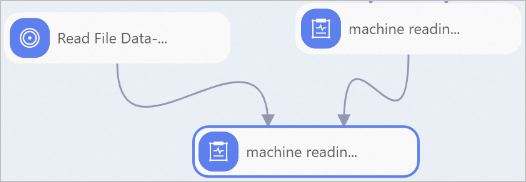The machine reading comprehension predict component of Platform for AI (PAI) allows you to make batch predictions by using the models trained by the machine reading comprehension training component. This topic describes how to configure the component and provides an example on how to use the component.
Limits
You can use the machine reading comprehension predict component based on Deep Learning Containers (DLC) resources.
Configure the component in Machine Learning Designer
Input ports
Input port
Data type
Recommended upstream component
Required
input saved model
OSS
Yes
Data for Prediction
OSS
Yes
Component parameters
Configure the component on the pipeline page of Machine Learning Designer. The following table describes the parameters.
Tab
Parameter
Description
Fields Setting
Language
The language of the input file. Default value: zh. Valid values:
zh
en
Input Schema
The data schema of each column in the input file. Separate multiple columns with commas (,). Default value: qas_id:str:1,context_text:str:1,question_text:str:1,answer_text:str:1,start_position_character:str:1,title:str:1.
Question Column
The name of the column that contains questions in the input file. Default value: question_text.
Context Column
The name of the column that contains text passages in the input file. Default value: context_text.
Answer Column
The name of the column that contains answers in the input file. Default value: answer_text.
Id Column
The name of the ID column in the input file. Default value: qas_id.
Start Position Column
The name of the column that contains the starting positions of answer spans in the input file. If the answer to a question can be found in the text passage, the starting position of the answer span is recorded in this column. Default value: start_position_character.
Output data file
The path of the Object Storage Service (OSS) bucket that stores the answer file used by this component.
Use User-defined Model
Specifies whether to use a custom model. Default value: no. Valid values:
no
yes
OSS Directory for Alink Model
This parameter is required only if you set the Use User-defined Model parameter to yes.
The path of the OSS bucket that stores the custom model.
Parameters Setting
batchSize
The number of samples that you want to tprocess at the same time. If the model is trained on multiple servers that use multiple GPUs, this parameter specifies the number of samples that are processed by each GPU at the same time. The value must be of the INT type. Default value: 256.
Sequence Length
The maximum length of a text passage that can be handled. The value must be of the INT type. Default value: 384.
Max Query Length
The maximum length of a question that can be handled. The value must be of the INT type. Default value: 64.
Max Answer Length
The maximum length of an answer that can be handled. The value must be of the INT type. Default value: 30.
Doc Stride
The length of a sliding window for each sliced text passage. The value must be of the INT type. Default value: 128.
pretrainModelNameOrPath
The name or path of the pre-trained model provided by the system. Default value: hfl/macbert-base-zh. Valid values:
User Defined
hfl/macbert-base-zh
hfl/macbert-large-zh
bert-base-uncased
bert-large-uncased
Additional Parameters
The custom parameters. You can fine-tune the model parameters based on your data.
Format:
{A: xxx, B: xxx}. Separate keys and values with colons (:). Separate multiple parameters with commas (,).Tuning
GPU Machine type
The instance type of the GPU-accelerated node that you want to use. The default value is gn5-c8g1.2xlarge, which indicates that the node uses 8 vCPUs, 80 GB memory, and a single P100 GPU.
num_GPU_worker
The number of GPUs for each worker. Default value: 1.
Example
The following figure shows a sample pipeline in which the machine reading comprehension predict component is used.
Perform the following steps to configure the component:
Prepare a prediction dataset and upload the dataset to an OSS bucket. For more information, see the "Upload an object" section in the Get started by using the OSS console topic.
A dataset can be in the TSV or TEXT format and contains the following columns: ID column, text column, question column, answer column (optional), start position column (optional), and title column (optional).
In this example, a TSV file is used to show how to train a model.
Use the Read File Data -3 component to read the prediction dataset. Set the OSS Data Path parameter of the Read File Data component to the OSS path in which the prediction dataset is stored.
Connect the Read File Data-3 component to the machine reading comprehension predict component as an upstream node and configure the machine reading comprehension predict component. For more information, see the "Component parameters" section of this topic.
References
You can use the machine reading comprehension predict component together with the machine reading comprehension training component. For more information, see machine reading comprehension training.
For more information about Machine Learning Designer components, see Overview of Machine Learning Designer.
Machine Learning Designer provides various preset algorithm components. You can select a component to process data based on your actual business scenario. For more information, see Component reference: Overview of all components.